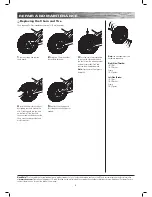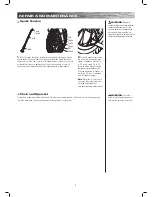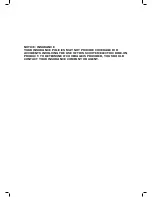
6
Need Help?
Visit our web site for replacement parts, product support, a list of authorized service centers in the US and customer service contact information
at
www.razor.com
. Please have the product I.D. code (located on the white label of your product) available for better assistance. Additional Customer Service
contact information is listed at the back of this manual.
2
Maker sure power switch is in
the
OFF
position. Plug the charger
into the charger port. The light on
the charger should turn red during
charging then back to green when
charging is complete.
WARNING:
Use ONLY
with the recommended charger.
Batteries are only to be charged
under adult supervision. The
charger is not a toy. Always
disconnect the charger before
wiping down and/or cleaning the
motor bike with a damp cloth.
The charger supplied with the
motor bike should be regularly
examined for damage to the cord,
plug, enclosure and other parts.
In the event of such damage, the
electric motor bike must not be
charged until it has been repaired
or replaced.
Chargers have built-in overcharge
protection to prevent battery from
being overcharged.
Note:
If the charger gets warm
during regular use, this is a normal
response and is no cause for
concern. If your charger does not get
warm during use, it does not mean
that it is not working properly.
Wall outlet - Green
Wall outlet and unit - Red (charging)
Wall outlet and unit - Green (charged)
Note:
Continue charging unit even if
light turns green prior to 12 hours.
WARNING:
Failure to
recharge the battery at least once a
month may result in a battery that
will no longer accept a charge.
1
Plug the charger into a wall
outlet. The light on the charger
should be green.
Note:
If green light (LED) does not
light up, try a different outlet.
Your electric motor bike may not have a fully charged battery; therefore you must charge the battery prior to use.
• Initial charge time: 12 hours.
• Recharge time: up to 12 hours, even if the light
turns green. Recommended maximum charging time
is 24 hours.
• Always charge the battery immediately after riding.
• Fully charge battery before storing for extended
periods of time.
• Unplug charger from the wall outlet when not in use.
• Failure to recharge battery periodically may result in a
battery that will not accept a charge.
• Make sure the power switch is turned
OFF
when
unit is not in use. If the power switch is left on for an
extended period of time, the battery may reach a stage
at which it will no longer hold a charge.
• To ensure long battery life, never store the product in
freezing or below freezing temperatures! Freezing will
permanently damage the battery.
• Run time: Up to 40 minutes of continuous ride time.
Run time may vary depending on riding conditions,
rider weight, climate, and/or proper maintenance.
• Battery life can vary depending on proper maintenance
and usage of the unit.
Note:
Make sure power is turned
OFF
when unit is not in use. If
the power switch is left on for
an extended period of time, the
battery may reach a stage at
which it will no longer hold a
charge.
PRE-RIDE CHECKLIST
Brake
Check the brakes for proper function. When you squeeze the
lever, the brake should provide positive braking action. Make
sure that brakes are not rubbing when the lever is released.
Tires
Periodically inspect the tires for excess wear and regularly
check the tire pressure. Reinflate as necessary.
Frame, Fork and Handlebars
Check for cracks or broken connections. Although broken frames
are rare, it is possible for an aggressive rider to run into a curb
or object, and wreck and bend or break a frame. Get in the habit
of inspecting your motor bike on a regular basis.
Hardware/Loose Parts
Before every ride, check all parts, such as nuts, bolts, cables,
fasteners, etc., to ensure they are secure and assembled
correctly. There should not be any unusual rattles or sounds
from loose parts or broken components. If the unit is damaged,
do not ride.
Reference “Safety Warnings” on page 1 of
this manual.
Safety Gear
Always wear proper protective gear, such as an approved safety
helmet. Elbow pads and kneepads are recommended. Always wear
athletic shoes (lace-up shoes with rubber soles) and keep shoelaces
tied and out of the way of the wheels, motor and drive system.
NEVER RIDE BAREFOOTED OR IN SANDALS.
Laws and Regulations
Always check and obey any local laws or regulations.
Insurance
Do not assume that your existing insurance policies necessarily
provide coverage for motor bike use. Check with your insurance
company for information regarding insurance.
CHARGING THE BATTERY
Charger


































